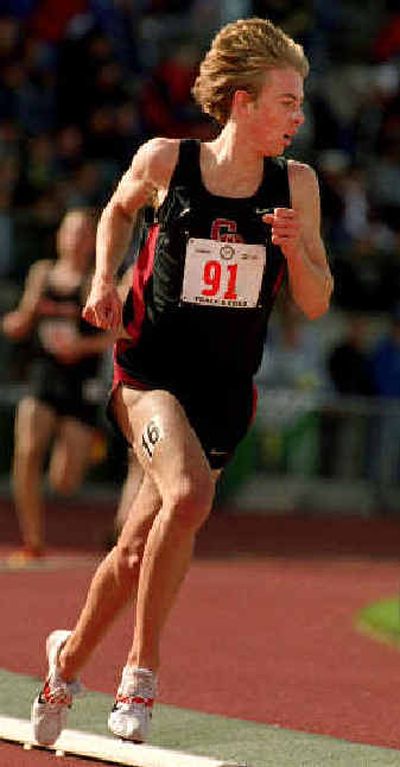Rupp embarks on a track life after high school fame

PORTLAND — Light on his feet and graceful, Galen Rupp seems to have little in common with the late Steve Prefontaine, the barrel-chested Oregon track legend tragically killed in a car accident in 1975.
Rupp’s stature belies his talent, which some say is as close as anyone in the state has come to that of his idol – the grinding runner known as “Pre.”
The 18-year-old from Portland’s Central Catholic concluded his high school career last weekend by capturing a pair of state titles in the OSAA track and field championships at Hayward Field on the University of Oregon campus.
With his coach and mentor Alberto Salazar looking on, Oregon track’s latest prep sensation ran away with both the 3,000 and the 1,500 meters.
Just as track fans once sported T-shirts reading “Stop Pre,” a group of students at the state meet sold shirts that said “Stop Rupp.”
Rupp is flattered by the attention, just as Pre was, but while Prefontaine was flamboyant, referring to his loyal followers as “My People,” Rupp is low key.
“I don’t think I talk as much as he did. He was a pretty vocal guy. But he backed it up, so there’s nothing wrong with doing that,” Rupp said.
“Every race he ran he laid it on the line,” the teenager added. “There was no race he did not give everything to. He’s an inspiration to everybody, I think.”
It was thought that he might try to break Prefontaine’s long-standing record in the 3,000, but Rupp strategically hung back and finished in 8:22, well behind the meet record of 8:10.66 set by Canby’s Eric Logsdon in 2000.
Prefontaine set the all-time state record of 8:08 in the 3,000 while at Marshfield in 1969.
“He is smart,” Salazar said about Rupp. “He’s been exposed to a lot of top runners, and he realizes that the object is to win races and keep winning. At some point as you beat people, you’ve got to run fast times, because you’re running against better and better people. The goal is to learn to win – and eventually the times will come.”
A day later Rupp set a new meet record of 3:49.76 in the 1,500, breaking the previous mark of 3:50.49 set by Klamath Union’s Lauren Jespersen in 2002.
“Watching him in the state meet and seeing his times, and knowing that he’s being coached by Alberto and isn’t overtrained, I’m real impressed,” said Tom Jordan, who wrote a book about Prefontaine and is director of the Prefontaine Classic track meet. “He might be the state’s best distance runner since Pre, and maybe of all time.”
Salazar was a constant presence at the meet and the pair’s professional relationship is about to get all the more intense as Rupp graduates from high school to devote himself full time to running.
Salazar won the New York City Marathon in 1980, repeated in 1981 with a record-breaking time of 2 hours, 8 minutes and 13 seconds, then repeated with a victory in 1982. No other American has won the event since.
Salazar, 45, met Rupp in 2000 at a Central Catholic barbecue. Rupp was a freshman on the school’s varsity soccer team but Salazar – the school’s cross-country coach – saw potential. Soon Rupp was a devotee.
After winning his second straight state cross country title in November, Rupp set the all-time state prep record in the 1,500 at Nike’s corporate headquarters in Beaverton.
Rupp ran the mile in 4:01.8, breaking the state prep record of 4:04.9 set by Dirk Lakeman of South Eugene in 1977. At the 1,500-meter mark, Rupp was clocked at 3:45.3, also a state record.
Rupp’s inspiration, Prefontaine, was one of Oregon’s most beloved athletes of all time.
Hailing from a blue-collar background in Coos Bay, Prefontaine was the country’s top prep distance runner by the time he was a senior at Marshfield.
Talent and tenacity carried Pre to every American distance record from 2,000 to 10,000 meters. He held eight American marks when he died. But his two most prized goals, a world record and Olympic gold medal, eluded him. He finished fourth in the 5,000 at the 1972 Olympics in Munich.
Pre was just 24 when he died.
Rupp will make his next appearance in the open meet named after his hero – the Prefontaine Classic, set for June 19 at Hayward Field. Rupp plans to run the mile in hopes of breaking the four-minute mark.
“Galen strikes me as much more of your prototypical distance runner with the long stride, the smooth style,” Jordan said. “Pre had the mentality of a boxer or someone in a contact sport. He was very aggressive.”
Rupp said his immediate aspiration is qualifying for July’s Olympic Trials in Sacramento, and beyond that, perhaps an Olympic medal some day.
But the impression is that Rupp isn’t really thinking about specific goals – he’s just enjoying the ride.
“You can only worry about competing against yourself,” Rupp said. “You obviously want to have goals and try and break records, but ultimately you compete against yourself,” he said. “I just want to see how far I can go, if I run well later, that’s great, but if not, there’s more to life than running.”